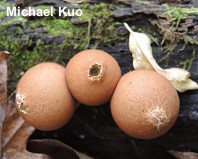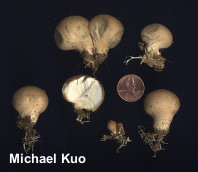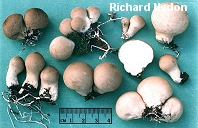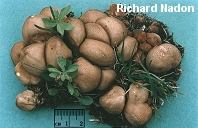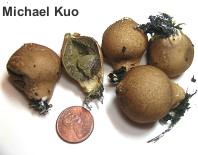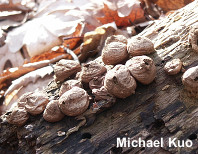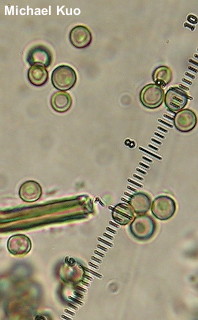| Major Groups > Puffballs > Lycoperdon pyriforme |

|
Lycoperdon pyriforme [ Basidiomycota > Agaricales > Agaricaceae > Lycoperdon . . . ] by Michael Kuo Lycoperdon pyriforme is one of only a few puffballs that grow on wood, which makes it fairly easy to identify. Other distinguishing features include the fact that its outer surface is only finely spiny, with spines that usually wear off; and the long white mycelial strings attached to its stem, which is often pinched off at the Desiccated, putrefied, shredded, tattered, and otherwise foul specimens of Lycoperdon pyriforme are often encountered by mushroom hunters in the spring, since the little puffballs have amazingly tough skins that can survive for months, sometimes even over winter. An early DNA study of this species (Krüger & Kreisel, 2003) looked at a single gene (the large subunit of RNA, known as LSU); data in this study supported placing Lycoperdon pyriforme in the genus Morganella, as "Morganella pyriformis." However, more recent studies that have included other genes (Bates 2004; Larsson & Jeppson, 2008; Bates and collaborators, 2009) have not supported placement in Morganella—although it is clear that our little friend is probably not a Lycoperdon, either. A revision of this group, based on careful study of many specimens, is desperately needed. Description: Ecology: Saprobic on the deadwood of hardwoods or conifers; growing scattered or, more typically, in dense clusters (sometimes covering logs with hundreds of fruiting bodies); usually appearing in fall and early winter, but sometimes fruiting in spring and summer; very widely distributed and common in North America. The illustrated and described collections are from Colorado, Illinois, and Québec. Fruiting Body: More or less round when young, but by maturity usually shaped like an inverted pear; 2–3.5 cm wide; 2–4.5 cm high; dry; covered with tiny white spines when young and fresh; spines usually disappearing by maturity; typically with a pinched-off base; by maturity developing a central perforation through which spores are liberated by rain drops and wind currents; pale tan to yellowish brown; with a white, fleshy interior at first; later with yellowish to olive granular flesh and eventually filled with brownish spore dust; base attached to numerous white rhizomorphs. Chemical Reactions: KOH negative on surfaces. Microscopic Features: Spores 3.5–4.5 µm; globose; smooth; without a pedicel. Capillitial threads olive to brownish in KOH; 3–5 µm wide; aseptate; without pores. REFERENCES: Schaeffer, 1774. (Persoon, 1801; Saccardo, 1888; Coker & Couch, 1928; Smith, 1951; Smith, Smith & Weber, 1981; Arora, 1986; Breitenbach & Kränzlin, 1986; Phillips, 1991/2005; Lincoff, 1992; Metzler & Metzler, 1992; Horn, Kay & Abel, 1993; Barron, 1999; Krüger & Kreisel, 2003; Bates, 2004; McNeil, 2006; Miller & Miller, 2006; Larsson & Jeppson, 2008; Bates et al., 2009; Trudell & Ammirati, 2009; Kuo & Methven, 2014; Desjardin, Wood & Stevens, 2015; Evenson, 2015; Siegel & Schwarz, 2016.) Herb. Kuo 10310703; Herb. DBG ROMO2012 5028-13; Herb. EIU 009. This website contains no information about the edibility or toxicity of mushrooms. |
© MushroomExpert.Com |
|
Cite this page as: Kuo, M. (2016 November). Lycoperdon pyriforme. Retrieved from the MushroomExpert.Com Web site: http://www.mushroomexpert.com/lycoperdon_pyriforme.html |

